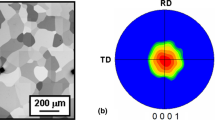Summary
A simple constitutive equation involving only six material constants has been developed to describe the high temperature deformation of metals over a wide range of stress and temperature. The model involves a drag stress and a back stress, along with their evolution equations. A new concept has been introduced to connect the growth behavior of these two internal state variables so as to reduce the number of material constants required in the description under cyclic loading conditions. It is demonstrated that this simple model can adequately describe the stress-strain behavior of a 617 Nickel-base superalloy over three different orders of strain rate, and up to 900°C. It can also provide the cyclic hardening behavior and stable hysteresis loop under a strain-controlled loading, and the strain-ratchetting under an off-axis, stress-controlled loading, among others. The influence of stress and temperature on creep, and the influence of mechanical and thermal cycling on the creep strain accumulation can all be studied with this set of simple constitutive equations.
Similar content being viewed by others
References
Frost, H. J., Ashby, M. F.: Deformation-mechanism maps. Oxford: Pergamon 1982.
Weng, G. J.: A micromechanical theory of high temperature creep. J. Appl. Mech.54, 822–827 (1987).
Bingham, E. C.: Fluidity and plasticity. New York: McGraw-Hill 1922.
Hohenemser, K., Prager, W.: Über die Ansätze der Mechanik isotroper Kontinua. Z. angew. Math. Mech.12, 216–226 (1932).
Malvern, L. E.: The propagation of longitudinal waves of plastic deformation in a bar of material exhibiting a strain-rate effect. J. Appl. Mech.18, 203–208 (1951).
Perzyna, P.: Fundamental problems in viscoplasticity. Adv. Appl. Mech.9, 243–277 (1966).
Bodner, S. R., Partom, Y.: Constitutive equations for elastic-viscoplastic strain-hardening materials. J. Appl. Mech.42, 385–389 (1975).
Kocks, U. F.: Laws for work-hardening and low temperature creep. ASME J. Eng. Mater. Tech.98, 76–85 (1976).
Miller, A. K.: An inelastic constitutive model for monotonic, cyclic and creep deformation I & II. ASME J. Eng. Mater. Tech.98, 97–113 (1976).
Estrin, Y., Mecking, H.: A unified phenomenological description of work hardening and creep based on one-parameter models. Acta Metall.32, 57–70 (1984).
Walker, K. P.: Creep crack growth predictions in INCO 718 using a continuum damage model. 2nd Symposium on Nonlinear Constitutive Relations for High Temperature Applications, Cleveland, OH, 1984.
Yao, D., Krempl, E.: Viscoplasticity theory based on overstress. The predictions of monotonic and cyclic proportional and nonproportional loading paths of an aluminum alloy. Int. J. Plasticity1, 259–274 (1985).
Chaboche, J. L., Nouailhas, D.: A unified constitutive model for cyclic viscoplasticity and its applications to various stainless steels. ASME J. Eng. Mater. Tech.111, 424–430 (1989).
Chaboche, J. L.: Cyclic viscoplastic constitutive equations. Parts I and II. J. Appl. Mech.60, 813–828 (1993).
Valanis, K. C.: A theory of viscoplasticity without a yield surface. Part I and II. Arch. Mech.23, 517–535 (1971).
Valanis, K. C.: Fundamental consequence of a new intrinsic time measure — plasticity as a limit of the endochronic theory. Arch. Mech.32, 171–191 (1980).
Bazant, Z. P.: Endochronic inelasticity and incremental plasticity. Int. J. Solids Struct.14, 691–714 (1978).
Wu, H. C., Yip, M. C.: Endochronic description of cyclic hardening behavior for metallic materials. ASME J. Eng. Mater. Tech.103, 212–214 (1981).
Watanabe, O., Atluri, S. N.: Constitutive modeling of cyclic plasticity and creep, using an internal time concept. Int. J. Plasticity2, 107–134 (1986).
Anand, L.: Constitutive equations for the rate-dependent deformation of metals at elevated temperatures. ASME J. Eng. Mater. Tech.104, 12–17 (1982).
Abd El-Azim, M. E., Mohamed, K. E., Mammad, F. H.: The deformation characteristics of alloy 800 H and alloy 617. Mech. Mater.14, 33–46 (1992).
Author information
Authors and Affiliations
Rights and permissions
About this article
Cite this article
Lu, Z.K., Weng, G.J. A simple unified theory for the cyclic deformation of metals at high temperature. Acta Mechanica 118, 135–149 (1996). https://doi.org/10.1007/BF01410513
Received:
Issue Date:
DOI: https://doi.org/10.1007/BF01410513




